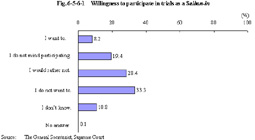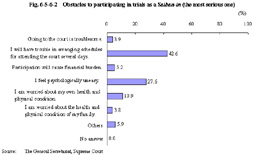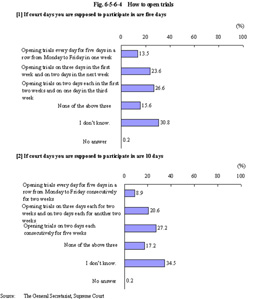| Previous Next Index Image Index Year Selection | |
|
|
1 Problems (1) Willingness to participate in trials as a Saiban-in Fig. 6-5-6-1 shows the answers to the question, "Do you want to participate in trials as a Saiban-in when you are selected?"
Fig. 6-5-6-1 Willingness to participate in trials as a Saiban-in Only about 28% of respondents answered either "I want to" or "I do not mind participating," while about 62% of them answered either "I do not want to" or "I would rather not." The percentage was high for those unwilling to participate in trials as a Saiban-in.(2) The most serious obstacle to participate in trials as a Saiban-in To the question, "What are the obstacles you have to participating in trials on several weekdays (Mon. to Fri.) one month later?", the largest number of respondents (nearly 65%) answered "I will have trouble in arranging schedules for attending the court several days," followed by those who answered "I feel psychologically uneasy" (nearly 53%), "going to the court is troublesome" (nearly 26%), "participation will cause financial burden" (nearly 24%), "I am worried about my own health and physical condition" (nearly 21%), and "I am worried about the health and physical condition of my family" (nearly 13%).
Fig. 6-5-6-2 shows the answers to the question, "Please cite the most serious one among these obstacles." Fig. 6-5-6-2 Obstacles to participating in trials as a Saiban-in (the most serious one) Those who answered "I will have trouble in arranging schedules for attending the court several days" were the largest in number, accounting for nearly 43%, followed by those who answered "I feel psychologically uneasy" (nearly 28%). Judging from the fact that these two answers accounted for nearly 70% of the total, it is important to ease these two obstacles as much as possible so as to develop a favorable environment where the general public can feel willing to participate in trials as a Saiban-in.(3) The maximum number of days on which the general public can participate in trials and the number of times of trials for cases covered by Saiban-in trials Fig. 6-5-6-3 shows the answers to the question, "How many days in a row at the longest can you participate in trials when you are selected as a Saiban-in? Five days in a row means all weekdays (Mon. to Fri.) of a week and 10 day in a row means all weekdays (Mon. to Fri.) of two consecutive weeks. Please answer on the premise that you are supposed to come to the court at nine in the morning and leave the court at five in the afternoon."
Fig. 6-5-6-3 Number of days that respondents can participate in trials in a row If trials are opened every day in a row, the largest number of respondents (nearly 39%) answered they can participate in trials "for three days or less" at the longest. However, a significant number of people answered a maximum number of days longer than three days. Nearly 8% of respondents answered "for four to five days," and a total of nearly 5% answered "for six to 10 days" or "for 11 days or more." Adding up these figures, a total of nearly 52% can participate in trials, if trials conclude within three days in a row (or trials are opened three times or less).Furthermore, Fig. 6-5-6-4 [1] and [2] show the answers to the question, "Please choose ways to open trials that you can participate in, if the number of court days you are supposed to participate in as a Saiban-in is (1) five days and (2) 10 days. Please answer on the premise that the trial schedule is determined prior to the selection of Saiban-ins." Fig. 6-5-6-4 How to open trials Those who chose the way to open trials on several days in each week with some intervals in between accounted for nearly 50% and nearly 48% when supposing the number of court days as five and as ten, respectively.To the question, "If trials are opened not from Monday to Friday in a row but on several days in each week with some intervals in between, how many days in total can you participate in trials?", the largest number of respondents (nearly 25%) answered "three days or less" as the maximum. There were also respondents who answered larger numbers of days. Nearly 14% answered "four to five days," and a total of nearly 19% answered "six to 10 days," "11 to 20 days," or "21 days or more." These figures were larger by nearly 6 points and nearly 13 points, respectively, compared to the percentage of the same answers when supposing that trials are opened every day in a row. Adding up these figures, a total of nearly 57% can participate in trials, if trials conclude within three days with some intervals in between (or trials are opened three times or less). In the meantime, looking at the percent ratio by number of times of trials for all persons finally disposed in the first instance for cases covered by Saiban-in trials, "three times or less," which more than 50% of the Questionnaire Survey respondents answered that they can participate in, accounted for only nearly 39%. Trials were opened "over three times but six times or less" for nearly 36% and "over six times" for nearly 25% of the total (see Section 5 of this Chapter). |



